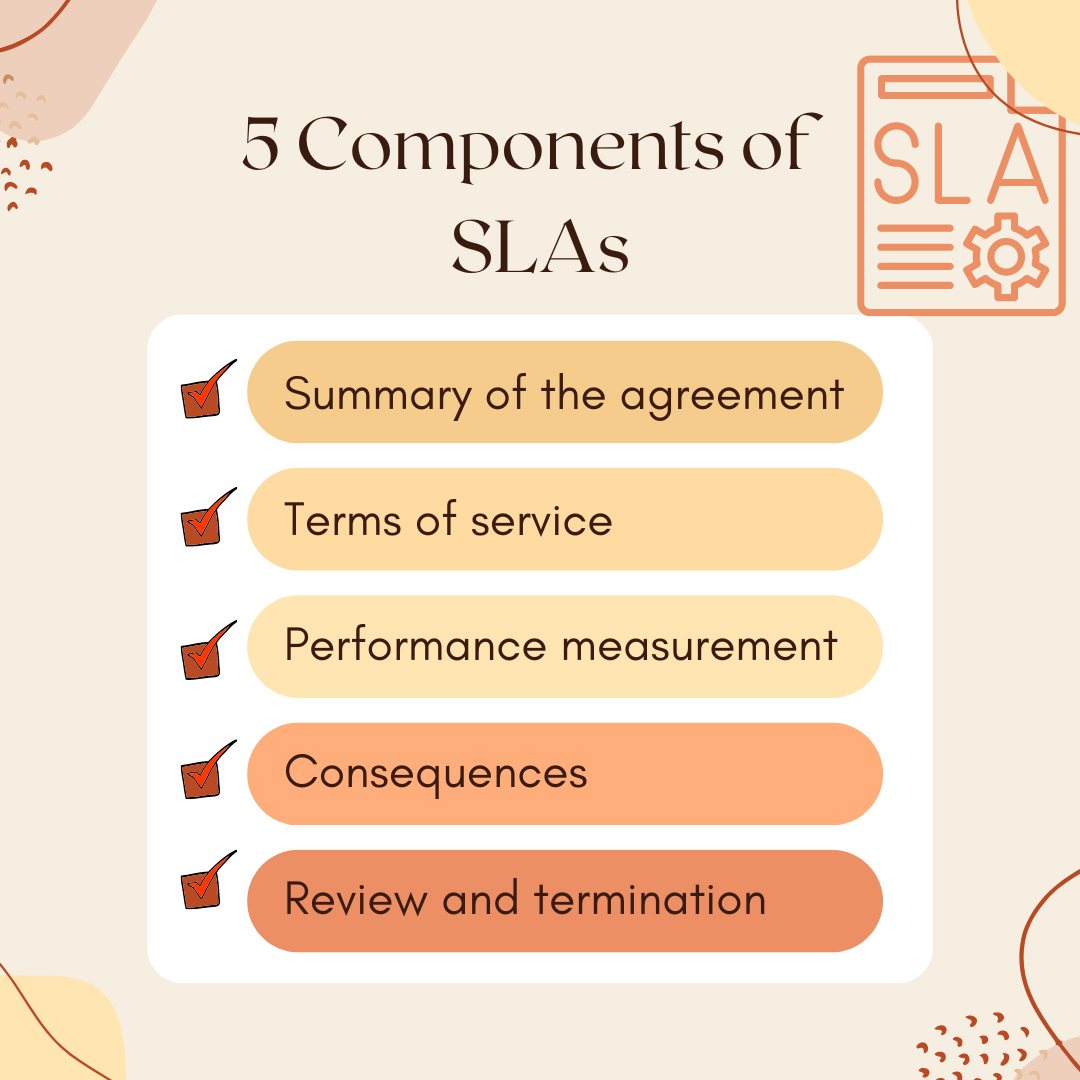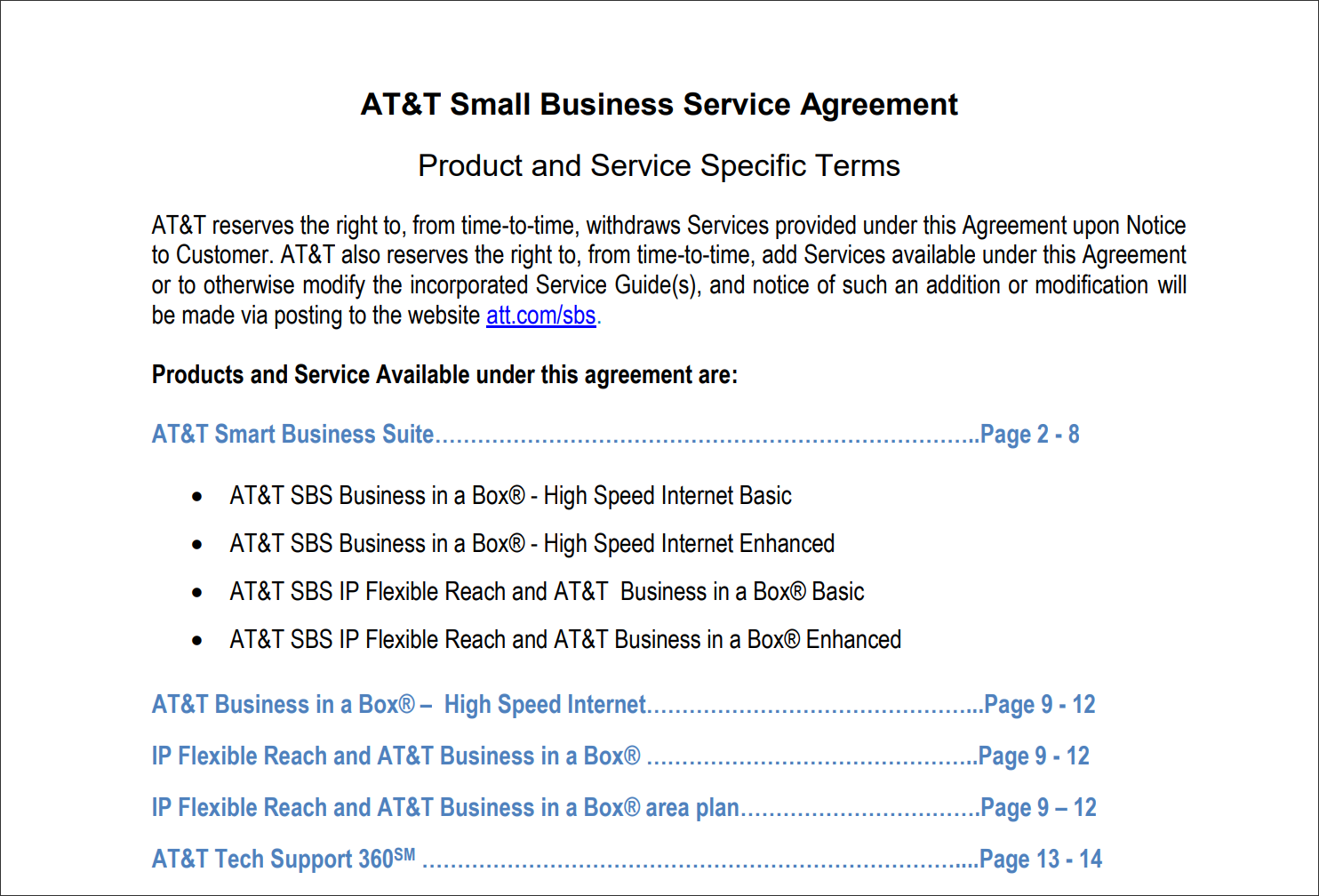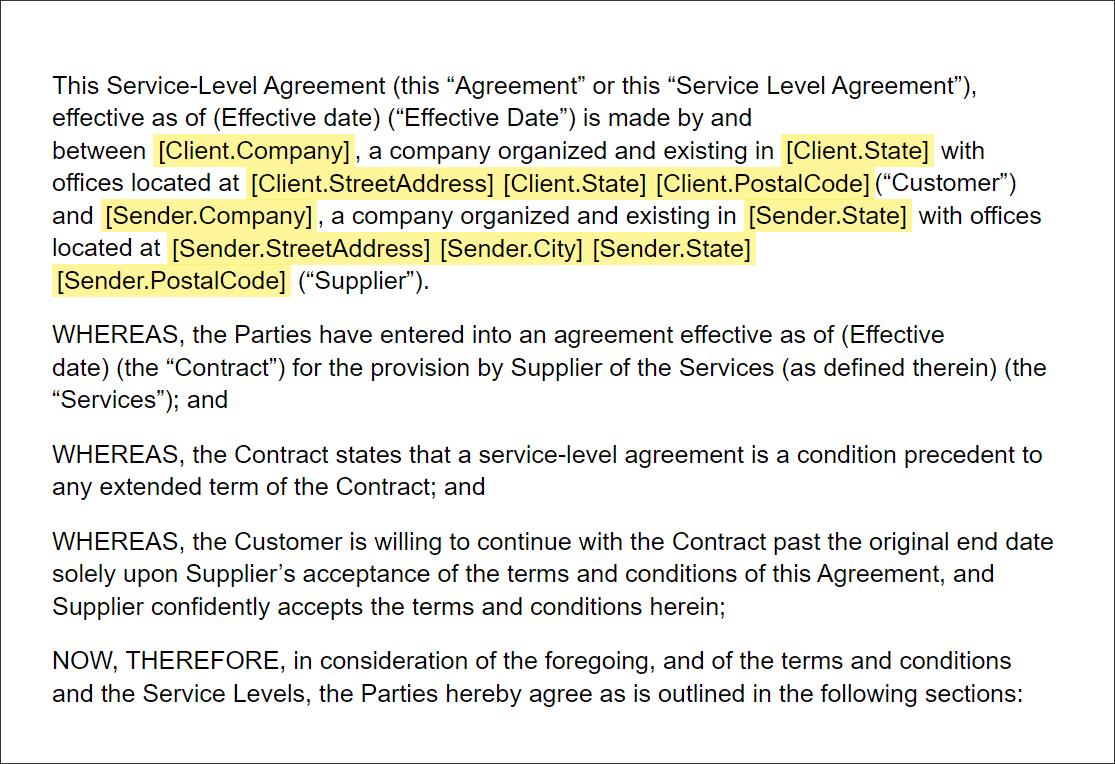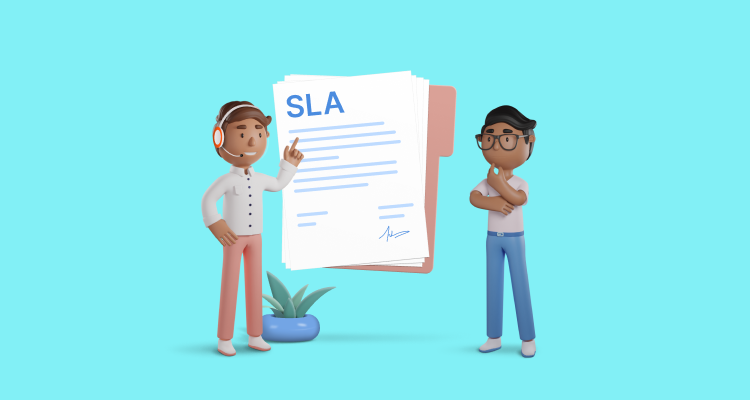Most service providers are aware of the importance of service level agreements (SLAs) with their clients and business partners.
A service level agreement is essential at the start of every product or service offering.
In this guide, I’ll take you through the following:
- What is a service level agreement?
- Types of SLAs, their components, and the advantages they offer.
- Steps to implementing SLAs for customer support
What is an SLA?
This type of agreement specifies the precise services a client can expect from a company upon purchasing its product or service.
The contract can include the delivery time for products, procedures for reporting problems, and the response and resolution times for support requests.
It also usually includes consequences for breaching the agreement. SLAs protect the interests of both the business and customers by outlining procedures and expectations.
Learn more about the service level agreement through this article.
Types of SLAs
Service-level agreements vary depending on the nature of the services and the provider-client relationship. Each type of agreement requires specific terms and conditions to which both parties involved must agree.
These terms often include details about services, priorities, responsibilities, guarantees, and warranties. Here are the main types:
Customer-based agreements: This is an agreement with an individual customer or group covering all the services they use. It contains details regarding the type and quality of service that has been agreed upon.
For example, a company may have a service-based agreement with its IT provider covering all its digital services.
Service-based agreements: This type is an agreement that pledges a specific service standard to all customers using the services provided.
For example, a telecommunication company may guarantee a specific internet bandwidth to all its customers.
Multilevel agreements: This type is broken down into levels, each addressing different sets of customers for the same services in the same agreement. A multilevel agreement may include a component at the corporate level that is applicable to all users, along with a distinct agreement specifically designed for a particular customer group.
For example, the telecom company might offer basic services and support to all its customers, but it could also present varying price tiers that determine different levels of service.
Components of SLAs
These are the some of the common components that should be included in these agreements.

Summary of the agreement
This overview of the agreement holds descriptive information like the parties involved, the dates, and the broad elements of the agreement.
It describes the mode and form of production. Moreover, the summary includes the signatories required to make the agreement official.
Terms of service
This component specifies the conditions in which to expect the services. It explains who will provide the services, to whom, when, and how long it should take.
It also includes detailed information on services that the service provider will not offer. In addition, the terms of service detail specifics like the security precautions that each side must take.
Performance measurement
This component lists and describes the methods for determining whether the parties abide by the terms of service after establishing them.
Moreover, it typically involves metrics and agreement on where, how, and how often the service provider will be report them.
This part lets managers track the performance of their teams and make timely adjustments to their workforce or processes that help them keep up with the service-based agreement standards.

Consequences
Plans for exceptions are necessary in any agreement, in case unforeseen events prevent one party from fulfilling its responsibilities.
However, the agreement must also explicitly state the repercussions of not upholding promises outside of these exceptions.
This component protects both parties, spelling out both the compensation due in these circumstances and the method of requesting it.
Review and termination
Sections for review and termination outline how and when your contract and service-based agreement will be looked at and updated, if necessary.
In addition, the agreement outlines the procedure for ending the contract. This part covers the mechanisms for both the natural end of a partnership and circumstances where early termination is proper.
This component protects the interests of both parties.
What advantages do SLAs offer?
In an environment where reliability and accountability are paramount, SLAs serve as formalized contracts that clearly outline the expectations and responsibilities between service providers and their clients, ensuring a seamless and trust-based relationship.
Below are some compelling advantages of SLAs in business.
Standard SLAs give security to buyers and suppliers equally
A service-based agreement describes the responsibilities that a company and its customers have to one another. It holds both parties accountable.
If one party does not carry out these responsibilities, they may have to terminate the partnership and compensate the other party, as laid out in the agreement. This safeguards each party.
It is simple for companies to see their current status with regard to deliverables and for customers to get the services they require confidently.
Stipulates quality and performance measures
Agreements define specific metrics for evaluating service quality. When suppliers sign an agreement, they agree not to fall below these standards.
For example, a broadband provider usually guarantees a certain amount of bandwidth and near-immediate responses to emergency customer support requests.

Defines expectations
A service-based agreement defines clear expectations for customers, the company, and its support staff in quantifiable and reliable terms.
Furthermore, it holds the company accountable for fulfilling the terms of its agreement. In this way, it prevents unpleasant surprises, since it lays out the dos and don’ts to both parties.
Thus, it promotes transparency and a good business environment.
Sets performance goals
Internal agreements help your employees achieve high performance. For example, they set standards and quotas for your support agents based on metrics specific to their development and your goals.
For example, you can set the monthly performance expectation of agents. This gives them specific targets and the ability to track how well they’re doing themselves, leaving no surprises in performance reviews.
As a result, it keeps your agents focused on producing the best customer service.
Outlines solutions for non-performance
Under-performance from your support team can cause the loss of customers. For instance, if a ticket is not solved in a timely manner, a customer can be irritated enough to look for an alternative to your brand.
While support software can keep the situation from getting this bad, a process still needs to be set up. It should evaluate why the agents overlooked the ticket and how to keep this from happening to other tickets.
An external agreement determines the consequences to the company in case of any breaches.
On the other hand, an internal one can clarify whose responsibility an oversight is and the consequences to specific teams or roles.
Strengthens relationships between customers and the support team
To ensure long-term success, companies should handle internal and external connections well. A service-level agreement is an incredible tool to establish trust between a company and its customers, ensure quality service, and satisfy customers.
The agreement provides a transparent contract between customers and the support team. When both parties accept it, there will be a lower chance of misunderstanding while service is provided.
Steps to implementing SLAs for customer support
To implement a service-based SLA, you have to be organized and precise. The following are the most effective methods for implementing a customer service agreement for your support team:
1. Set realistic SLA terms
Examine how well you’re doing with your current agreements. Take stock of your resources and how they relate to the commercial goals of your firm. Afterward, set terms in new agreements that are in line with your commercial goals and current capabilities.
2. Create a draft
By creating draft SLAs, you can refine the terms with input from your internal team leads. Depending on your service or product, you may seek customer input for SLAs with specific companies.
By doing this, you cut out unnecessary requirements and ensure everything necessary is covered.
3. Define the SLA terms plainly
SLAs define the terms under which you serve your customers and their obligations to your company. To guarantee that both parties meet these terms, you must adjust the language of the agreement to improve the understanding of both your customers and employees.
Input from your legal department is necessary. However, you should write and summarize the terms in plain language.
4. Add reminders
To avoid overdue support tickets, you should use a reminder system. These reminders will notify your agents when their assigned tickets are approaching their SLA-mandated due dates.
That way, the agent can either re-prioritize or request a new agent for urgent tasks.

For instance, you can add reminders for the following SLA metric targets:
- First response
- Updates
- Resolution
For first responses, support software can automate sending acknowledgement emails, which helps your team save time.
5. Add escalation procedures
Escalation should happen when the due date for a ticket has passed. A customer service agreement specifies the procedure for when this occurs.
With help desk software, this usually involves automated notifications sent to the assigned agent and that agent’s supervisor. They can update the customer and take action.
By adding an escalation procedure in your level of agreement, you ensure tickets are not overlooked indefinitely. It also ensures customers are updated on progress.

6. Monitor and update the SLA regularly
To avoid problems between your agents and your customers, you need to have a regular review and update of your agreement. How often this occurs should also be set in the customer service SLA.
Sometimes what sounds good initially fails to work out in practice. You can check that both parties are getting what they require from the standard SLA and are able to meet those requirements.
This helps you keep the business relationship functioning. Adjusting your service-based agreement to match the relationship’s reality increases both employee and customer satisfaction.
Service level agreement examples and templates
Service level agreements can be simple or detailed, depending on the complexity of the service provided.
Following are some SLA templates and examples that can help you get started.
BoldDesk’s SLA templates
BoldDesk offers a versatile customer service platform that helps companies manage service expectations and deliver exceptional customer service experiences.
With our straightforward SLA templates, you can craft clear expectations for response and resolution times, ensuring that every support ticket is handled with the urgency and care it requires.
Users can personalize each SLA with a unique name and description, define hours of operation, and set no-nonsense conditions to meet their specific customer service goals.

With BoldDesk, you can track key help desk SLA metrics such as first response times and resolution rates for continuous performance monitoring.
BoldDesk helps support teams stay accountable to their customers for prompt, accurate service with SLA-set goals.
AT&T’s small business SLA
AT&T’s service-level agreement establishes a clear contract between AT&T and its clients, defining the terms of their interaction.
The SLA agreement utilizes bullet points to make each detail clear and understandable.

PandaDocs SLA template
PandaDoc’s SLA templates provide a framework for defining the level of service expected by a customer from a supplier.
PandaDoc’s service-level agreement templates are crafted with industry-standard language, helping businesses draft complex SLA contracts.
These templates outline the methods of measuring the quality of service, as well as the remedies or penalties that will be given if the agreed-upon service levels are not achieved.

Achieve customer service excellence with well-defined service level agreements
Every company needs to create smart SLAs to regulate quality and expectations. This is regardless of the type of product or service you provide and the number of end users with which you deal.
When both your customers and employees are clear about what to expect and what is expected of them, everyone is more satisfied.
BoldDesk helps you to implement the best SLA metrics and methods. Sign up for our free trial package for your customer support. Contact us to schedule a 30-minute live demo to experience the best help desk SLA in customer service today.
We hope this blog was informative. Feel free to share your feedback in the comments section below.
Related articles


















 Email Ticketing System
Email Ticketing System Shared Inbox Software
Shared Inbox Software Multi Brand Help Desk
Multi Brand Help Desk Internal Help Desk Software
Internal Help Desk Software Trouble Ticketing Software
Trouble Ticketing Software Mobile Help Desk
Mobile Help Desk 















